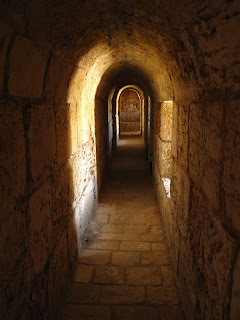So, now to discuss today's topic: The Tower of David. This museum of sorts lies just inside the Old City wall at the Jaffa Gate (there are various entrances into the Old City, each with its own name), and is comprised of remnants of a palace dating back to the 1st century, a contemporary gallery with local art, and exhibitions detailing the history of Jerusalem. As I am sure you have noticed by now, Jerusalem has been in the hands of many different rulers and each ruling period is marked by a distinct style or religion. It can be pretty overwhelming to keep track of the timeline of this city, so a museum like this that breaks it all down into manageable pieces is a nice compliment to all of the tour books and History Channel YouTube videos (yes, we do normally watch educational videos to help make sense of everything we are experiencing!). Someday I will try to put together a timeline of the different ruling periods, but I have a feeling it will turn into a bigger project than I am anticipating :)
Here are a few pictures from our morning at the Tower. I will mention one fact that was especially interesting about this fortress: When the Crusaders took over the Tower, they built a moat around the walls for added protection. However, being that Jerusalem is located in the middle of the desert and water is scarce, the moat was never filled. I suppose even an empty moat provides some extra protection from invaders, but we thought it was funny that the builders would consider adding a moat that they knew could never be filled.
A model of the Tower of David fortress as it stands today. Along the left you can see the dry moat that runs along the outside of the walls.
Happy tourists :)
This model of Jerusalem was built in 1872 by a Hungarian immigrant. It is hard to see here, but he captured so many details of the city and the model itself is quite large (maybe 8 feet by 7 feet or so?). After being shown in a few fairs around Europe, the model was tucked away and forgotten in the Geneva Public Library for 64 years. It was uncovered in 1984 and moved back to Jerusalem for renovation and display.
The courtyard at the Tower of David.
View of the Temple Mount and Mount of Olives from one of the towers.
Pathways through the fortress walls.
Standing on the bridge just outside the main gate to the Tower, this is a view of the bustling area just inside the Jaffa Gate in the Old City.








No comments:
Post a Comment